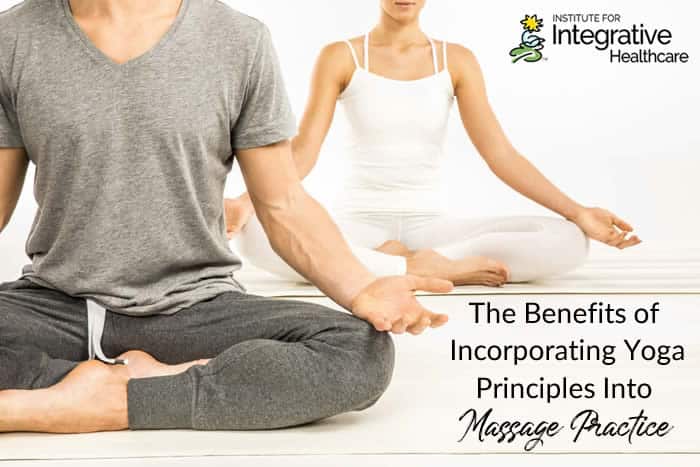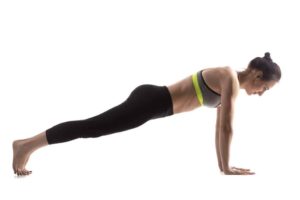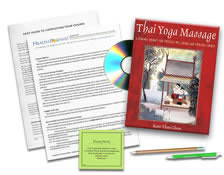

Famous Indian guru Patanjali in 400 BCE wrote the Yoga Sutras describing eight primary yoga principles. Collectively, these eight principles are referred to as Ashtanga, also called “eight limbs,” which guide yoga students on living a life of peace, harmony and purpose.
This article explores how a massage therapist may gear their efforts congruently with these principles in mind.
The 8 Yoga Principles Described by Patanjali
1. Yamas: Ethical behavior, conducting ourselves with kindness and respect towards others.
Five behavior categories include:
- Ahimsa—Nonviolence
- Satya—Truthfulness
- Asteya—Non-stealing
- Brahmacharya—Continence
- Aparigraha—Non-covetness
2. Niyamas: Self-discipline, behaviors to enrich ourselves.
Five manners of self-discipline include:
- Saucha—Cleanliness
- Samotsa—Contentment
- Tapas—Heat
- Svadhyaya—Study of scriptures
- Isvara Pranidhana—Surrender to Source
3. Asana: Physical practice of performing postures in yoga practice.
4. Pranayama: Breathwork conducted during yoga practice.
5. Pratyahara: Drawing awareness within one’s self introspectively.
6. Dharana: Singular concentration, avoiding vacillations of the mind.
7. Dhyana: Being in a state of existence of Dharana.
8. Samadhi: State of ecstasy, bliss, joy.
Of the eight yoga principles, the first four (yamas, niyamas, asana and pranayama) can be easily incorporated into massage practice. The latter four principles (pratyahara, dharana, dhyana and samadhi) can be addressed within a personal yoga and meditation practice. I highly encourage everyone to look into these self-care practices deeper to develop these principles which contribute to clarity of mind, body and spirit.
Yamas refer to ethical actions and behaviors towards other people. As a massage therapist, we are very conscious of how our clients perceive our touch and how we treat them upon the table. Some key ideas stemming from this principle include nuanced elements of a therapy session.
The idea of Asteya, non-stealing, can be honored in massage practice. If a therapist advertises a full 60-minute session while providing only 55 minutes of service, this essentially robs the client of 5 minutes of session time. This may not seem like much, yet there is still the ethical dilemma presented that the client did not receive full service for the treatment. Ensuring full treatment time is one way of honoring yamas in massage practice.
Satya, the notion of truthfulness, can also be honored in massage practice. A therapist needs to be truthful with clientele about their competency, understanding and realistic options for clients with health conditions. Inflating one’s stance or attempting techniques while not fully trained (no, a YouTube video does not count as training) will create a condition of potential harm for the client. Ensuring trust built on truthfulness is another way of honoring Yamas in massage practice.
Niyamas may refer to a therapist’s self-care practice. Considering the physical, mental and emotional toll upon the body, a therapist needs a self-care regiment to remain as healthy as possible. Tapas is a concept which easily applies as these represent the activities one employs to stay healthy. These means may include stretching, self-massage, foam rolling, yoga postures, Tai Chi and QiGong maneuvers, and core strengthening. Ask any therapist working at least a decade and inevitably the term “self-care” is shared regarding career longevity and practice building.
Saucha, the concept of cleanliness, is vital for the success of a massage practice. Clientele can be easily turned off from an unclean massage environment. Ensuring hygienic standards are met each day may seem tedious yet is fundamental to the successful massage therapist. Be sure to sanitize all equipment, product holders, furniture and tools used upon the body thoroughly.
The idea of studying scriptures, Svadhyaya, can be incorporated into massage practice. For some people, the word scripture applies perfectly; whereas for others, replace the word “scripture” with the term “spiritually uplifting literature” for a neutral approach to this concept. As one reads spiritually uplifting literature, the mind is brought more clarity in everyday life. This enhanced clarity brings greater awareness in life which translates to greater awareness upon the massage table. The therapist will hold a more professional space with a heightened attunement to the environment and the client’s body. This will lend towards a more aware therapist and enlightened massage practice.
Performing asanas (yoga postures) between massage sessions can be an excellent way of keeping one’s self prepared each session and avoiding overuse injuries often felt by massage therapists. These exercises will provide many benefits to the therapist.
- First, increased flexibility of joints will aid our ability to use our bodies during sessions in pressure application as well as healthy flow around the body.
- Second, the isometric nature of asanas will strengthen our muscles reducing risk of injury and aiding in deeper pressure application.
- Third, a therapist’s posture will better align reducing pain and injury potential from improved posture.
- Finally, greater concentration may develop as one holds asanas, even when not comfortable, which brings about body awareness.
Here are two easy asanas for a therapist to perform before or between sessions.
Tree Pose

From standing position, place hands on hip to support your body. Lean your body weight upon one foot, then slowly bring the opposite foot along the medial side of the straight leg. Begin softly with bringing the opposite foot upwards upon the straight leg. The foot may lie just above the ankle at first. If you feel you can maintain balance, then bring foot to below the knee. If this is easy, bring foot above the knee. Never place the foot upon the knee. When you find a comfortable spot for your foot either above or below the knee of straight leg, bring your arms either in front of your chest or above your head with palms touching. Repeat upon both legs.
Plank Pose

From table-top position (hands and knees), straighten your legs and bring yourself upon your toes. With your hands at shoulder level, straighten your arms, tuck your core deep into yourself and hold this position with a straight back for as long as tolerable.
Many people need to raise their hips as the hips may easily come forward to the floor to compensate. The average person holds this initially for only 5-10 seconds. Be kind to yourself as you practice this pose as you progress towards holding this pose for 30 seconds or a minute. Repeat several times.
Breathwork
Incorporating Pranayama, breathwork, in massage and bodywork efforts can be quite powerful. These can be incorporated either by the therapist themselves in self-care or self-preparation practice, or by coaching a client through breathwork either prior to or during session.
First, a therapist can easily prepare one’s self for their day or destress in the midst of a stressful day with effective pranayama. An example of an easy breathwork exercise to incorporate is often called “Three-Part Breath.” A person imagines three chambers of their torso in which air may enter, the lower belly (below umbilicus), the upper belly (above umbilicus) and the chest region. As one inhales, they imagine filling the lower belly, then upper belly, then chest pausing for a moment at this point. As one exhales, they imagine emptying the chest, then upper belly, then lower belly pulling belly to spine to engage the core as breath is completed.
The rhythmic cycle of Three-Part Breath can be extremely relaxing and help someone feel grounded and centered when one feels stressed. Visualizing a color to one’s breath can make this exercise easier.
Second, a therapist can include breathwork practices for a client upon the massage table. If a client exhibits verbal or nonverbal cues of restrictions releasing or feeling uncomfortable, breathwork can calm this client to a point they can receive again in session. Also, you may have a client who talks a great deal. This may be a form of releasing or may be distracting from the treatment goals of the present session. Calming this person with breathwork will bring a client back to a place in which they can receive a session more profoundly.
Once a client has been calmed with breathwork, they may be quite surprised upon the session’s end how much more they benefited from being in a calmer state upon the treatment table. A therapist can encourage this client to breathe in the same manner at home whenever they feel stressed with life.
An example of guiding a client through breathwork upon the table can be using a “count of four” breath. The therapist will coach the client to inhale for four seconds, pause (hold) their breath for four seconds, then extend the exhale for four seconds. If a client feels four seconds is too easy or not effective, this can be done for more seconds, provided client does not have any adverse reaction such as becoming dizzy or physically begins to tense neck or chest muscles too long.
Conclusion
As a massage therapist incorporates yoga principles into their massage practice, one recognizes an abundance within one’s life and massage business. “Energy flows where attention goes” applies here as one places mental attention on facilitating a heightened conscious awareness within one’s life practice which will align with their business effort. This alignment yields success professionally and greater health personally.












